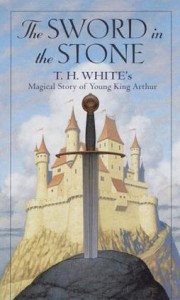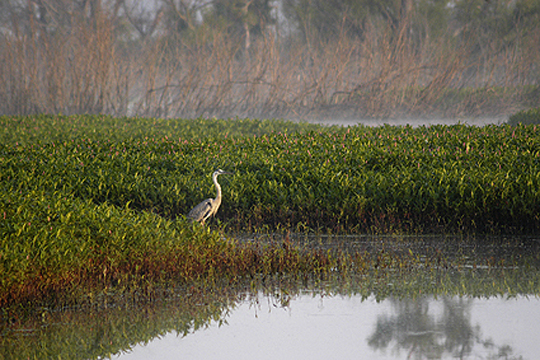The Sword in the Stone
 T.H. White’s The Sword in the Stone (1938) is spoken of in my Benet’s Reader’s Encyclopedia as “a witty and erudite fantasy of Arthur’s boyhood, which combines affectionate satire on 20th-century English manners and mores with broad humor and deep knowledge of both nature and the Middle Ages.” Thank you, Benet’s, for capturing my own hyperbolic reaction to the book so compactly, because otherwise I might ramble on and on about what it is before getting to why I liked it. It’s not a children’s book, but it’s the most optimistic and lovingly written tale I’ve read in ages, and sometime before year’s end I’ll read (or reread, because I have a sinking feeling I’ve read them before but have virtually NO MEMORY of them!) the other tales that make up The Once and Future King. Here’s what I liked, in ascending order:
T.H. White’s The Sword in the Stone (1938) is spoken of in my Benet’s Reader’s Encyclopedia as “a witty and erudite fantasy of Arthur’s boyhood, which combines affectionate satire on 20th-century English manners and mores with broad humor and deep knowledge of both nature and the Middle Ages.” Thank you, Benet’s, for capturing my own hyperbolic reaction to the book so compactly, because otherwise I might ramble on and on about what it is before getting to why I liked it. It’s not a children’s book, but it’s the most optimistic and lovingly written tale I’ve read in ages, and sometime before year’s end I’ll read (or reread, because I have a sinking feeling I’ve read them before but have virtually NO MEMORY of them!) the other tales that make up The Once and Future King. Here’s what I liked, in ascending order:
1.) The satire isn’t bitter. Take this short dialogue, in which two infinitely civil British noblemen prepare for a joust, as an example:
“Nice day,” said Sir Grummore.
“Yes, it is nice, what?”
“Been questin’ today?”
“Oh, yes, thank you. Always am questing, you know. After the Questing Beast.”
“Interestin’ job, that, very.”
“Yes, it is interesting. Would you like to see some fewmets?” (Fewmets are droppings of the beast pursued.)
“By Jove, yes. Like to see some fewmets.”
“I have some better ones at home, but these are quite good, really.”
“Bless my soul. So these are her fewmets.”
“Yes, these are her fewmets.”
“Interestin’ fewmets.”
“Yes, they are interesting, aren’t they? Only you get tired of them,” added King Pellinore.
“Well, well. It’s a fine day, isn’t it?”
“Yes, it is rather fine.”
“Suppose we’d better have a joust, eh, what?”
Jousting is an absurd tradition, the narrator seems to say, but you can’t help but love these good-natured old “fellahs” who have time for polite conversation as they prepare to try and ram one another through. It reminds me of a kinder, gentler Monty Python. At first passages like this bothered me a bit, because they’re very leisured and slowed me down. I’ve become (to my irritation) someone who’s always in a hurry to get through this book and on to the next one, and this book doesn’t consent to being “gotten through”; it meanders. Once I was reconciled to that, I found myself smiling and chuckling often. The book is filled with eccentric characters, and passages like these, that acknowledge the silliness of much of human life without getting riled up about it. The fun is broken up periodically by moments of startling pathos, and these episodes show that the book is more than a lighthearted romp; its optimism is convincing because it includes the whole spectrum of experience.
2.) The philosophy of education makes me wish I were a wizard like Merlyn, the tutor in this story. Want to learn about aquatic life? Become a fish, like Merlyn causes the Wart to do. (The Wart is a mere boy in this story, but destined to become the legendary King Arthur.) Birds? Become a hawk for a night. Or an ant. Or a goose. Or, in the culminating chapter on the Wart’s education, a badger. No notebooks. No textbooks. No, I take that back; there are a few schoolroom subjects, but they’re not at all the meat and potatoes of Merlyn’s instruction. There’s a running comparison between the “first rate eddication” of Sir Kay (the Wart’s nobleman peer), and that of the Wart, that continually pits book-learning against the far more effective and high-stakes school of experience. The Wart’s education is part of what distinguishes him, for Merlyn doesn’t give Sir Kay the same advantages.
As a homeschooler supposedly following the classical model, I find Merlyn’s style of teaching-by-zapping mighty appealing. So does the Wart: “I think I ought to have some eddication,” he tells Merlyn on one particularly dreary day. “I can’t think of anything else to do.” Merlyn is offended: “You think education is something which ought to be done when all else fails?” he demands. “Well, some sorts of education,” the Wart replies miserably. I love this perception of education as entertainment! But by the end of the story, the badger hones down the purpose of learning to two goals: “So Merlyn sent you to me to finish your education,” he remarks to the Wart. “Well, I can teach you two things — to dig, and love your home. These are the true end of philosophy.” I like the badger’s perspective, living as I do in an age when education is often seen as the mere acquisition of information. The badger suggests we need to desire knowledge enough to dig for it, and then let love dictate how we put it to use.
3.) Third and last, I like the novel’s concept of heroism. The Wart is thoroughly convincing as a young boy. He’s distinguished from Sir Kay and others in the story not as a superhero gifted with unusual strength or wisdom, but as someone who’s curious, humble, honest, polite and brave, haunted by a persistent wish to be a knight even though he’s destined for most of the story to be a mere steward. At his defining moment, when he’s faced with the sword in the stone, what comes to his aid is not bravery or strength but love: all the animals he’s met appear at the edges of the scene and shout encouragement. “Come along, Homo sapiens, for all we humble friends of yours are waiting here to cheer,” calls a bird. The Wart’s qualifications to be king include a deep understanding and respect not just for human life and affairs, but for all the living world. His defining act that proves his mettle as a king is public and undisputable. And his power and position come to him unsought, by surprise. In the midst of this year of presidential candidates vying for power, Arthur’s fitness to lead represents quite a contrast. An Arthurian president would be just the thing: undisputed readiness to govern, excellently balanced education that doesn’t lean in a sickly way toward either theory or practice, and an ability to rally all voices in the natural world. I know it’s childish, but if only the choice in “real life” could be as clear-cut as it is in this fantasy tale.


